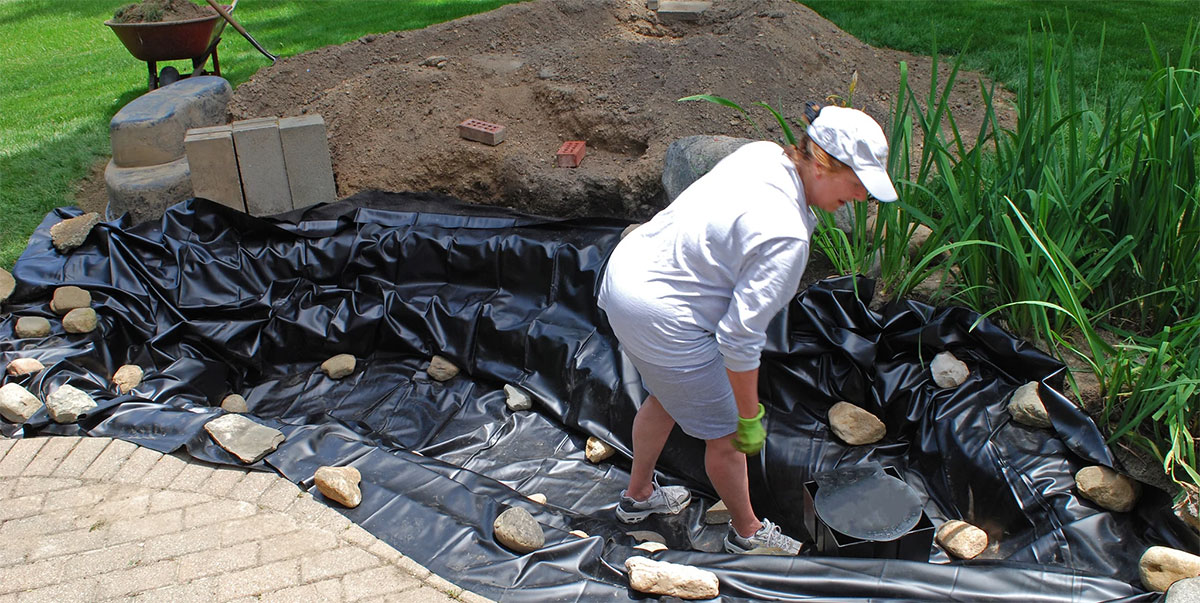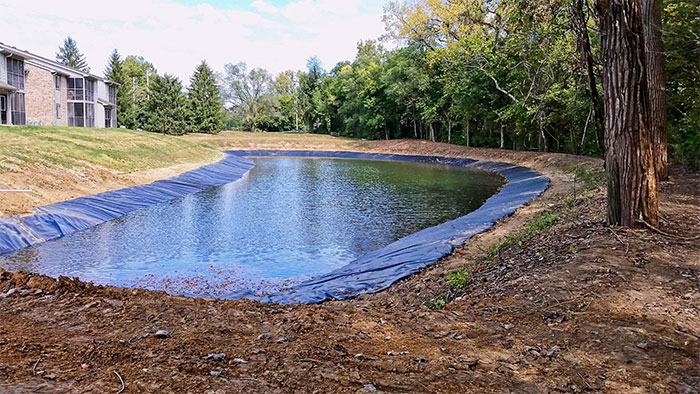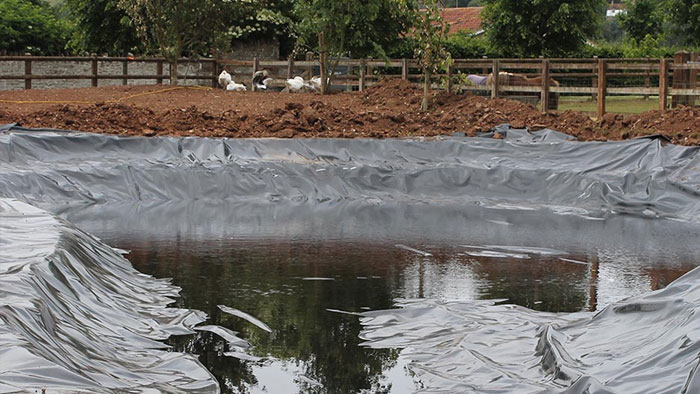
Selecting the ideal pond liner is essential for a successful pond construction project. Factors such as material, size, quality, and budget must be considered. By carefully evaluating these aspects, you can make an informed decision and ensure a durable and functional pond.
What is a pond liner?
A pond liner is a waterproof barrier used to create a contained area for water in ponds, water gardens, or other similar applications. It is typically made of a durable, flexible material designed to prevent water from seeping into the ground or leaking out of the pond. The liner acts as a barrier between the water and the surrounding soil.
Is using pond liners necessary?
Using pond liners is not always necessary, but it depends on the specific circumstances and goals of the pond project. Here are some factors to consider:
- Soil Composition: If the soil in the area where you plan to build the pond has a high clay content or is naturally dense and compacted, it may have good water retention properties. In such cases, a pond liner may not be necessary as the soil itself can act as a natural barrier to hold water.
- Water Table: If the groundwater level is relatively high in the area, it can cause water to seep into the pond from below. In such cases, a pond liner becomes essential to prevent water loss and maintain the desired water level.
- Pond Size: Smaller ponds, particularly those that are temporary or seasonal in nature, may not require a liner. These ponds can be created by excavating the soil and relying on the natural water table or rainfall to maintain water levels. However, larger permanent ponds or water features usually benefit from a liner to ensure long-term stability and water retention.
- Aquatic Life: If you plan to keep fish or other aquatic organisms in your pond, a liner is generally recommended. It helps to create a controlled environment, prevents water contamination from soil or pollutants, and ensures the pond remains a healthy habitat for the aquatic life.
- Aesthetic Considerations: A pond liner can provide a clean, polished look to the pond, creating a well-defined shape and preventing any irregularities that may occur with natural soil contours. It also helps to maintain clear water by preventing sediment and debris from entering the pond.
What kind of material is best as a liner for a pond?
Several materials can be used as liners for ponds, each with its advantages and considerations. The best material for a pond liner depends on factors such as budget, pond size, desired longevity, and specific project requirements. Here are three common options:
- EPDM (Ethylene Propylene Diene Monomer): EPDM is a synthetic rubber liner that is highly popular for pond construction. It is durable, flexible, and resistant to UV rays, weathering, and punctures. EPDM liners are available in varying thicknesses, providing excellent longevity and protection against leaks.
- PVC (Polyvinyl Chloride): PVC liners are another commonly used option. They are lightweight, easy to handle, and generally more affordable than EPDM. PVC liners are available in different thicknesses, and while they are UV resistant, they may degrade over time when exposed to prolonged sunlight.
- HDPE (High-Density Polyethylene): HDPE liners are a more recent addition to the market. They are highly durable, resistant to punctures, and have excellent chemical resistance. HDPE liners are typically supplied in large panels and require professional installation due to their thickness and rigidity.
Read more: Canal lining with geosynthetics
The challenges in pond liner construction
Here are some common challenges associated with pond liner construction:
- Site Preparation: Proper site preparation is crucial for a successful pond liner installation. Excavation must be done carefully to ensure the right depth, shape, and slope of the pond. It is essential to remove any sharp objects, rocks, or debris that could potentially puncture the liner.
- Liner Sizing and Seaming: Calculating the correct liner size and ensuring proper seaming can be challenging. If the liner is too small, it may not adequately cover the pond area, leading to leaks. If it’s too large, excessive folds or wrinkles can form, which may cause stress points or issues with water flow. Seaming the liner correctly is crucial to ensure a watertight seal.
- Wrinkles and Folds: Even with proper sizing, wrinkles and folds can occur during liner installation, especially in larger ponds or irregularly shaped ones. These wrinkles can create stress points and potentially lead to leaks or uneven water distribution. Careful smoothing and adjusting of the liner during installation can help minimize wrinkles.
- Protection Against Punctures: Pond liners are susceptible to punctures from sharp objects like rocks, tree roots, or animals. It is important to create a protective layer or cushioning beneath the liner, such as sand or geotextile fabric, to minimize the risk of punctures.
- Maintenance and Repair: Over time, pond liners may require maintenance or repair. UV exposure, freezing temperatures, and natural wear and tear can potentially damage the liner. Regular inspection, cleaning, and prompt repair of any tears or punctures are necessary to maintain the integrity of the liner.
- Longevity and Durability: Choosing a liner material that is appropriate for the specific pond conditions is crucial for longevity and durability. Factors such as UV resistance, chemical resistance, and material thickness should be considered to ensure that the liner can withstand the environmental factors it will be exposed to.
Read more: What are the applications of geotextile ?
The advantages of using geomembranes in the lining of ponds
Using geomembrane sheets as liners in pond construction offers several advantages. Here are some key advantages of using geomembranes:
- Waterproof Barrier: Geomembranes, such as HDPE (High-Density Polyethylene) or PVC (Polyvinyl Chloride) liners, provide an excellent waterproof barrier.
- Chemical Resistance: Geomembranes are highly resistant to chemicals, making them suitable for ponds that may come into contact with various substances like fertilizers, pesticides, or industrial effluents.
- Longevity and Durability: Geomembranes are designed to be durable and have a long lifespan. They are resistant to UV degradation, punctures, and weathering, ensuring that the liner remains intact and functional for an extended period.
- Versatility: Geomembranes offer versatility in pond design and construction. They can be custom fabricated to fit ponds of various shapes and sizes, including irregular or complex contours. Geomembranes are flexible and can adapt to the specific requirements of the project, providing a seamless and uniform lining.
- Ease of Installation: Geomembranes are relatively easy to install compared to other lining options. They can be pre-fabricated to the desired size, reducing the amount of field seaming required.
- Environmental Protection: Geomembranes help to protect the environment by preventing the seepage of water containing pollutants or contaminants into the surrounding soil or groundwater.
- Maintenance and Repair: Geomembranes generally require minimal maintenance. They are easy to clean, and any necessary repairs can be performed with relative ease. Regular inspections and prompt repair of any damage or punctures help to ensure the long-term effectiveness of the liner.
Things to consider when purchasing a pond liner
When purchasing a pond liner, there are several important factors to consider to ensure you choose the right liner for your specific project. Here are some key points to keep in mind:
- Material: Consider the different types of pond liner materials available, such as EPDM (Ethylene Propylene Diene Monomer), PVC (Polyvinyl Chloride), or HDPE (High-Density Polyethylene). Each material has its advantages and considerations in terms of durability, flexibility, UV resistance, chemical resistance, and cost. Determine which material best suits your project requirements and budget.
- Size and Shape: Accurately measure the dimensions and shape of your pond before purchasing a liner. Ensure you have the correct dimensions to avoid purchasing a liner that is too small or excessively large. Consider any irregular contours or features that may require additional liner material or customization.
- Thickness: The thickness of the liner is an important consideration, as it affects its durability and resistance to punctures. Thicker liners generally offer better protection against sharp objects, but they can also be more expensive. Assess the potential risks in your pond environment and choose an appropriate thickness accordingly.
- Quality and Brand: Consider the reputation and quality of the manufacturer or brand when purchasing a pond liner. Look for reputable suppliers that offer high-quality liners known for their reliability and longevity. Read reviews or seek recommendations to ensure you choose a reputable product.
- Warranty: Check if the pond liner comes with a warranty. A warranty can provide peace of mind and assurance of the liner’s quality. Understand the terms and conditions of the warranty, including any limitations or requirements for maintenance and installation.
- Installation Requirements: Different pond liners may have specific installation requirements. Consider whether you have the necessary tools, equipment, or expertise to install the liner yourself. If not, factor in the cost of professional installation services when budgeting for the project.
- Budget: Determine your budget for the pond liner and associated materials. Consider the cost of the liner itself, as well as any additional materials required for installation, such as underlayment, adhesive, or protective padding. Balancing quality and cost is important to ensure you get a liner that meets your needs without overspending.
- Longevity and Maintenance: Assess the expected lifespan of the liner and its maintenance requirements. Some materials may require more regular maintenance or periodic inspections. Consider your willingness and ability to perform any necessary maintenance tasks to ensure the longevity of the liner.
Conclusion
Choosing the right pond liner is crucial for a successful project. Consider factors such as material, size, shape, thickness, quality, warranty, installation requirements, budget, and maintenance. Evaluate different materials like EPDM, PVC, or HDPE for durability and resistance. Measure accurately and choose a reputable brand. Balance cost and quality, and factor in maintenance needs. Seek guidance to make an informed decision and ensure a long-lasting pond.







